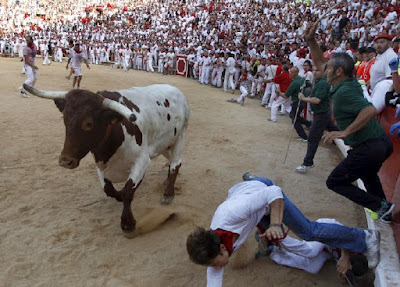The Spanish Fighting Bull (Toro Bravo, toro de lidia, toro lidiado, ganado bravo, Touro de Lide) is an Iberian heterogeneouscattle population. It is primarily bred free-range on extensive estates in Spain, Portugal and Latin American countries where bull fighting is organized. Fighting bulls are selected primarily for a certain combination of aggression, energy, strength, and stamina.
Some commentators trace the origins of the fighting bull to wild bulls from the Iberian Peninsula and their use for arena games in the Roman Empire. Although the actual origins are disputed, genetic studies have indicated that the breeding stock have an unusually old genetic pool and an unusual amount of DNA usually found in cattle in Africa, perhaps coming from the Maghreb and dating from the period of Moorish occupation of Spain.
The aggression of the bull has been maintained (or augmented, see above) by selective breeding and has come to be popular among the people of Spain, France and Portugal for the purpose of bullfighting. It was later introduced to Latin America by the Spanish settlers who wished to hold bullfights in their colonies. In May 2010, Spanish scientists cloned the first of the breed. The calf, named Got, meaning "glass" in Valencian, was cloned from a bull named Vasito and implanted into a Holstein host mother.
Very few times a year a bull will be indultado, or 'pardoned', meaning his life is spared due to 'outstanding' behavior in the bullring, leading the audience to petition the president of the ring with white handkerchiefs. The bullfighter joins the petition, as it is a great honor to have a bull one has fought pardoned. The bull, if it survives its usually severe injuries, is then returned to the ranch where he will live out his days in the fields. In most cases, it will become a 'seed bull' (he is mated once with some 30 cows and the offspring are tested after four years for their efficacy in the ring). In these circumstances a bull's lifespan can be 20 to 25 years.















0 Comments